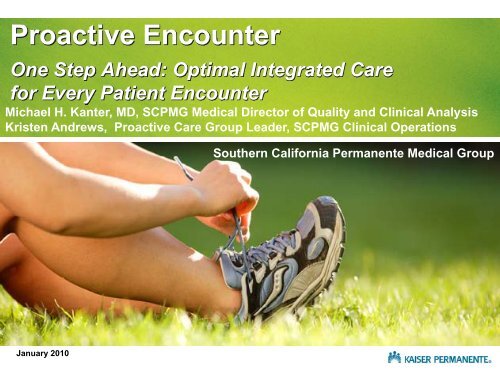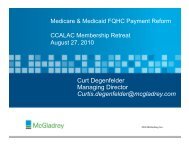Proactive Encounter One Step Ahead
Proactive Encounter One Step Ahead
Proactive Encounter One Step Ahead
Create successful ePaper yourself
Turn your PDF publications into a flip-book with our unique Google optimized e-Paper software.
<strong>Proactive</strong> <strong>Encounter</strong><br />
<strong>One</strong> <strong>Step</strong> <strong>Ahead</strong>: Optimal Integrated Care<br />
for Every Patient <strong>Encounter</strong><br />
Michael H. Kanter, MD, SCPMG Medical Director of Quality and Clinical Analysis<br />
Kristen Andrews, <strong>Proactive</strong> Care Group Leader, SCPMG Clinical Operations<br />
Southern California Permanente Medical Group<br />
January 2010
Goal<br />
<strong>Proactive</strong> Office <strong>Encounter</strong>:<br />
The project aims to improve the consistency and<br />
quality of preventive and chronic care by;<br />
• Activating ALL members of the healthcare team in<br />
providing a proactive patient care experience,<br />
• Embedding processes to support preventive and<br />
chronic care needs into standard workflows, and<br />
• Utilizing information technology tools for<br />
identification of patient care gaps.<br />
2<br />
Confidential & Proprietary
Target Population<br />
• All members in KPSC<br />
• Every outpatient encounter, including<br />
specialty clinics – Approximately 12<br />
million visits annually<br />
• Future plan: <strong>Proactive</strong> Inpatient<br />
<strong>Encounter</strong> and Call Center POE<br />
(Every patient, Every visit, Every time)<br />
3<br />
Confidential & Proprietary
Session Objectives<br />
Identify opportunities to create a highly reliable care process<br />
that will lead to:<br />
• Improved quality and patient care experience<br />
• Fewer missed opportunities to improve preventive care and chronic<br />
disease management<br />
• Increased efficiency<br />
• Optimal Clinician support in specialty care as well as primary care<br />
• Strategies to have specialty care departments provide primary<br />
prevention and cancer screening.<br />
Apply similar workflows/tools that will result in an increased<br />
partnership leading to:<br />
• Consistent support to physician practice,<br />
• Panel ownership and performance<br />
• Empowered and engaged staff<br />
• Better partnership between physician and health care team<br />
4<br />
Confidential & Proprietary
Presentation Agenda<br />
• Development of <strong>Proactive</strong> Office <strong>Encounter</strong> (POE)<br />
Strategy<br />
• Tools that support the workflow<br />
• POE Data<br />
• Future POE work<br />
5<br />
Confidential & Proprietary
Let’s make it personal.<br />
6<br />
Confidential & Proprietary
<strong>Proactive</strong> <strong>Encounter</strong> Patient Story<br />
• Dale Gordon, Kaiser Permanente member<br />
7<br />
Confidential & Proprietary
Making the Business Case<br />
Opportunities for Breast Cancer and Diabetes Management<br />
in Adult Primary Care<br />
Test<br />
Total<br />
Seen in<br />
Primary Care<br />
%<br />
Needing<br />
Mammogram<br />
Needing A1c<br />
test<br />
47,294 18,222 38%<br />
10,530 3,911 37%<br />
• Difficult to reach success if we only focus on Primary Care<br />
• Approximately 60% of our members are seen in Specialty Care where<br />
we have an opportunity to close these and other Care Gaps<br />
8<br />
Confidential & Proprietary
Clinical Outcome<br />
- Hospitalizations reduced; deaths avoided<br />
METRIC<br />
%<br />
Increase<br />
Lives Saved Per Decade<br />
Cholesterol Control 17.5% 1406 Lives<br />
Blood Pressure Control 36.2% 4972 Lives<br />
HbA1C < 9.0 8.7% 823 Lives<br />
Smoking Cessation 14.0% 787 Lives<br />
Breast Cancer Screening 11.6%<br />
580 Lives<br />
Cervical Cancer Screening 6.0% 39 lives<br />
Colon Cancer Screening 25.7% 4075 lives<br />
TOTAL<br />
12,684 Lives Saved<br />
9<br />
Confidential & Proprietary
<strong>Proactive</strong> <strong>Encounter</strong> embodies our<br />
integration strategy.<br />
10<br />
Integration is our strength and what sets us<br />
apart from the competition.<br />
Confidential & Proprietary
Partnership to Performance:<br />
Expected Outcomes<br />
11<br />
• Highly reliable care<br />
process<br />
– Improved quality<br />
– Fewer missed<br />
opportunities<br />
– Increased efficiency<br />
– Technology supports<br />
workflow<br />
– Industry-leading<br />
performance<br />
– Optimal MD support<br />
Confidential & Proprietary<br />
• Partnership<br />
– Physician and health<br />
care team<br />
– Consistent support<br />
to physician practice<br />
– Panel ownership and<br />
performance<br />
– Staffing supports<br />
model<br />
– Empowered and<br />
engaged staff
<strong>Proactive</strong> <strong>Encounter</strong> Experience<br />
Pre <strong>Encounter</strong><br />
<strong>Proactive</strong><br />
Identification<br />
• Identify missing<br />
labs, screening<br />
procedures, access<br />
management, kp.org<br />
status, etc.<br />
• Provide member<br />
instructions prior to<br />
visit<br />
• Contact member and<br />
document encounter<br />
in KP<br />
HealthConnect<br />
Office <strong>Encounter</strong><br />
Office <strong>Encounter</strong> Management<br />
• Vital sign collection /<br />
documentation<br />
• Identify and flag alerts for provider<br />
• Room and prepare patient for<br />
necessary exams<br />
• Pre-encounter follow-up<br />
<strong>Proactive</strong> Office Support<br />
• Phone calls<br />
• Letters<br />
• E-mail<br />
• Inbox Management<br />
Post <strong>Encounter</strong><br />
Immediate<br />
• After visit summary,<br />
after care<br />
instructions, followup<br />
appointments,<br />
Health Ed materials,<br />
how to access info<br />
on kp.org<br />
Future<br />
• Follow-up contact<br />
and appointments<br />
per provider<br />
12<br />
Confidential & Proprietary
Intervention Design<br />
- Key elements<br />
• Processes for staff to fill care gaps for all patients<br />
• Screenings<br />
– Pap, Mammogram, FOBT, DEXA<br />
• Lab Reminders<br />
– A1c, Microalbumin, LDL, Chlamydia<br />
• Immunizations<br />
– Flu, Pneumovax, Pediatric Immunizations<br />
• Chronic Conditions (DM, HTN, Persistent Asthma)<br />
– Retinal exam, shoes off for foot exam, glucose meters, health ed classes<br />
– Blood pressure measurements<br />
– Asthma questions to determine if patient is “in control”<br />
• Body Mass Index<br />
– Height and weight<br />
• Smoking inquiry<br />
13<br />
Confidential & Proprietary
Overview of<br />
<strong>Proactive</strong> <strong>Encounter</strong> Tools
Building Blocks of <strong>Proactive</strong> Care<br />
Performance<br />
Improvement<br />
Measuring Performance<br />
Train/Validate Skills of All Staff<br />
Physician Preference Sheet<br />
Specialty Specific Work Flows<br />
Standard Medical Office Work Flows<br />
15<br />
Confidential & Proprietary
<strong>Proactive</strong> <strong>Encounter</strong> Work Flows<br />
Standard Work Flows<br />
• Improve Quality<br />
• Improve Efficiency<br />
• Improve Physician support<br />
• For medical office visit<br />
• Supplemented by Specialty Specific Work Flows<br />
Work Flow Tools<br />
16<br />
• Standard POE Work Flows<br />
• Team Agreements<br />
• Video Tutorials<br />
• Job Aids<br />
• <strong>Proactive</strong> Care Booklet<br />
Confidential & Proprietary
Standard<br />
Work Flow<br />
17<br />
Confidential & Proprietary
<strong>Proactive</strong> Office <strong>Encounter</strong><br />
Team Agreement<br />
For Provider – MA/LVN/RN<br />
“Our Cause is Health. Our Passion is Service. We’re Here to Make Lives Better”<br />
Provider: Medical Assistant/LVN/RN: Meeting Date: _______________________<br />
We share responsibility for providing an outstanding care experience for our members, outstanding clinical care, outstanding performance in panel<br />
management/clinical goals, outstanding performance as a partner team/team member, and an outstanding working experience for our team.<br />
Ground Rules for Team Agreement Meeting<br />
This team agreement serves to enhance communication between the provider and medical assistant, LVN, or RN. During this meeting, we<br />
ask that team members treat each other with respect and remain open to new ideas. Use positive verbal and nonverbal feedback by asking<br />
rather than demanding. This is an opportunity for each team member to express their needs clearly. It should be based on a collaborative<br />
approach versus a “top-down” approach.<br />
Instructions:<br />
1. Meet together and determine what is important to your practice.<br />
2. Review “sample” team agreement and use as a guideline for your meeting.<br />
3. Below are statements that allow you to discuss your role(s) as it relates to POE. Discuss your roles using the sample document to assist you.<br />
4. Review and revise at agreed intervals. This living document serves to clarify the goals, roles, and procedures, as necessary, for effective teamwork.<br />
1. How do we start the day?<br />
2. Practice Guidelines and Documentation (Chief Complaint, Vital Signs, Medical and Social History, Demographics, Allergies, and Medications)<br />
Provider<br />
MA/LVN/RN<br />
18<br />
Confidential & Proprietary
<strong>Proactive</strong> <strong>Encounter</strong> Tools<br />
Administrative Tools<br />
‣Suggested Team with Roles and<br />
Responsibilities<br />
‣<strong>Proactive</strong> Care Readiness Check List<br />
‣Chart Review Tool<br />
‣Workflow Efficiency Audit Tool<br />
‣Physician Survey<br />
19<br />
Confidential & Proprietary
Readiness<br />
Checklist<br />
20<br />
Confidential & Proprietary
Physician<br />
Survey<br />
21<br />
Confidential & Proprietary
<strong>Proactive</strong> <strong>Encounter</strong> Tools<br />
Training Tools<br />
‣POE Skills Inventory<br />
‣Skills Validation Tool<br />
‣<strong>Proactive</strong> Care CD & Web Site<br />
• Videos<br />
• Job Aids<br />
• All Administrative & Work Flow Tools<br />
22<br />
Confidential & Proprietary
POE Skills<br />
Inventory<br />
23<br />
Confidential & Proprietary
Skills<br />
Validation<br />
Tool<br />
24<br />
Confidential & Proprietary
<strong>Proactive</strong> Care Tab<br />
Access to POE Checklists<br />
within HealthConnect<br />
screenshots
<strong>Proactive</strong> Care Activity Tab – Link to POE Checklists<br />
26<br />
Confidential & Proprietary
POE <strong>Encounter</strong> Checklist Display<br />
27<br />
Confidential & Proprietary
<strong>Proactive</strong> Pre-<strong>Encounter</strong>/<strong>Encounter</strong> Checklists<br />
Checklists will be<br />
generated for all<br />
patients identified<br />
as having gaps in<br />
care.<br />
28<br />
Confidential & Proprietary
<strong>Proactive</strong> <strong>Encounter</strong> Pediatrics Checklist<br />
29<br />
Confidential & Proprietary
<strong>Proactive</strong> <strong>Encounter</strong> Patient Story<br />
• Dr. Morrells, Kaiser Permanente Physician<br />
and Member<br />
30<br />
Confidential & Proprietary
<strong>Proactive</strong> <strong>Encounter</strong><br />
SmartTools
Adult <strong>Proactive</strong> <strong>Encounter</strong> SmartSet<br />
32<br />
Confidential & Proprietary
Adult <strong>Proactive</strong> <strong>Encounter</strong> Documentation<br />
SmartPhrase<br />
33<br />
Confidential & Proprietary
<strong>Proactive</strong> Office <strong>Encounter</strong><br />
Data
<strong>Proactive</strong> <strong>Encounter</strong> Tool Percent Utilization<br />
September 2008<br />
Target 75% utilization of POE Tools<br />
35<br />
Confidential & Proprietary
SCAL Regional Trend:<br />
POE Composite Successful Opportunities<br />
100<br />
90<br />
80<br />
70<br />
60<br />
50<br />
40<br />
30<br />
20<br />
10<br />
0<br />
Regional Successful Opportunities Report<br />
July 08 - August 09<br />
Percent Successful<br />
% A1c<br />
% Microalbumin<br />
% LDL<br />
% Mammo<br />
% Pap<br />
% Dexa<br />
% Pneumovax<br />
% Retinal screening<br />
% BMI<br />
% Flu<br />
% Smoking<br />
% Chlamydia<br />
% DM Health Ed<br />
% Asthma Quesr<br />
36<br />
Confidential & Proprietary
<strong>Proactive</strong> <strong>Encounter</strong> in Urgent Care<br />
Bellflower Service Area Pilot Project<br />
November Successful<br />
Opportunity Rates<br />
•Pap Smear – 35%<br />
160<br />
140<br />
Pap Smears in Urgent Care<br />
July - November 2008<br />
150<br />
•Mammogram – 40%<br />
120<br />
120<br />
114<br />
•A1c – 32%<br />
•MAU – 15%<br />
Total Pap Smears<br />
100<br />
80<br />
60<br />
90<br />
94<br />
•LDL – 25%<br />
40<br />
•Chlamydia – 33%<br />
37<br />
20<br />
0<br />
Jul-08 Aug-08 Sep-08 Oct-08 Nov-08<br />
Week<br />
Confidential & Proprietary
<strong>Proactive</strong> <strong>Encounter</strong> in Surgical Urgent Care<br />
Bellflower Service Area Pilot Project<br />
(October – November 08)<br />
38<br />
Confidential & Proprietary
Implementation Roadmap<br />
39<br />
Confidential & Proprietary
Implementation <strong>Step</strong>s<br />
• Develop the leadership team<br />
• Assess readiness<br />
• Share the vision and workflows<br />
• Create department/condition specific work flows<br />
• Develop the training team<br />
• Train and validate skills<br />
• Measure performance<br />
• Performance improvement<br />
40<br />
Confidential & Proprietary
Future: More <strong>Proactive</strong> <strong>Encounter</strong> work to<br />
continue through-out the year<br />
• In progress pilot of POE in Inpatient setting: <strong>Proactive</strong><br />
Inpatient <strong>Encounter</strong><br />
• In progress – Pilot analysis of Pre-<strong>Encounter</strong><br />
automatic calls to members due for labs<br />
• Additional care gap alerts to be included in POE<br />
• POE in Emergency Department capturing labs<br />
• Automated <strong>Proactive</strong> Care Workflow Assessment<br />
• Automated Outreach for Overdue Labs<br />
• Development of POE in Pharmacy<br />
41<br />
Confidential & Proprietary
<strong>Proactive</strong> Inpatient <strong>Encounter</strong> (PIE)<br />
Pre-Admission<br />
(ED/Pre-op)<br />
• Identify needed<br />
labs, screening,<br />
medication<br />
management, etc.<br />
• Provide member<br />
instructions<br />
Admission<br />
• Assessment,<br />
vitals, advance<br />
care directive<br />
documentation<br />
• Prepare patient<br />
for procedure,<br />
tests<br />
• Activate patient<br />
in care: education,<br />
nutritional consult,<br />
social service,<br />
discharge<br />
planning<br />
• Arrange DME,<br />
Home Health,<br />
Post Discharge<br />
Care<br />
Discharge<br />
• Identify and<br />
provide<br />
immunizations<br />
• Med reconciliation<br />
• Discharge care<br />
instructions, followup<br />
appointments,<br />
health ed materials<br />
• Screening<br />
reminders and<br />
appointments<br />
• KP.org registration<br />
• Post Discharge<br />
Call<br />
42<br />
Confidential & Proprietary
Complete Care Experience<br />
43<br />
Confidential & Proprietary
Success Factors<br />
- What practices and tools contributed to success?<br />
• Making it Personal<br />
• Regional pay for performance<br />
• Support the work: believe in it, implement it, reinforce it<br />
• Partner with your local POE Implementation Lead<br />
• Become familiar with elements of the POE model and workflow in<br />
Primary and Specialty Care<br />
• How to Document in HealthConnect TM (Chief Complaint, Vital<br />
Signs, Medical and Social History, Demographics, Allergies, and<br />
Medications)<br />
• How to use the POE Tool in POINT and POE Smartsets and Best<br />
Practice Alerts in HealthConnect TM<br />
• Understand how POE supports the physicians’ practice<br />
44<br />
Confidential & Proprietary
Success Factors<br />
- What practices and tools contributed to success?<br />
• Create a Standard Workflow Agreement<br />
45<br />
Confidential & Proprietary
Success Factors<br />
- What practices and tools contributed to success?<br />
• Physician direct involvement is critical to success of POE<br />
• Engage physicians or the MA will not see value and will not do it<br />
• Regional and local leadership support<br />
• Develop team agreements between your physicians and your nursing<br />
staff; this is a vital piece of the process<br />
• Implementation of Standard & Specialty Specific Workflows<br />
• Exam room readiness<br />
• Patient properly prepared for the examination<br />
• HealthConnect tasks pre-staged as appropriate<br />
• Better partnership between physician and healthcare team<br />
• Reward and recognize performance – “Nice Job”<br />
46<br />
Confidential & Proprietary
<strong>Proactive</strong> <strong>Encounter</strong> Patient Story<br />
• Mary Gonzales, Kaiser Permanente member<br />
47<br />
Confidential & Proprietary
QUESTIONS / FEEDBACK
Contacts<br />
Kristen Andrews<br />
<strong>Proactive</strong> Care Group Lead<br />
Kristen.L.Andrews@kp.org<br />
Michael Kanter, MD<br />
Medical Director of Quality and Clinical Analysis<br />
Michael.H.Kanter@kp.org<br />
49<br />
Confidential & Proprietary









